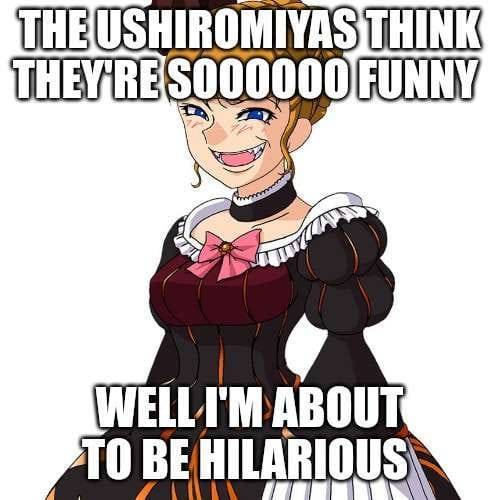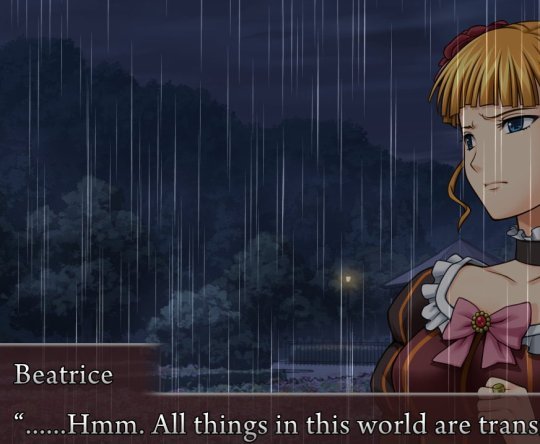#one's the icon of the exe file of the game so unavoidable
Explore tagged Tumblr posts
Text
btw for reference Here are all the spoiler glimpses of beatrice's form i've been accidentally exposed to for the sake of transparency and also so you can know how surreal/funny it is for me to be unravelling the meaning of this vicious murderwitch in canon while also seeing occasional iceberg tips of what seems to be some kind of extremely thorough and comprehensive blorbo memeification going on. i think you guys are doing some breaking bad fandom shit to this woman.




#umineko liveblog#one's the icon of the exe file of the game so unavoidable#and one was a random pfp so only having two legit spoilers sent my way isn't a bad track record#pointedly Not thinking too deeply about any of this to not ruin anything for myself#but i will say i'm very amused by how beatrice is seemingly presented as this whimsical jester-like figure who is pro trans rights#very funny considering her only confirmed action in the story was to viciously and spitefully murder a dysphoric twink (kanon)#how fake trans rights beatrice fans look when a REAL murderwitch rocks up#none of this is influencing my thinking since it's obviously all out of context Jokes with no basis in canon#but i think the discrepancy between the presentation of beatrice in the text (elusive haunting horror figure)#and the presentation of beatrice in this limited slice of fandom memes (silly girl. trans ally?) is baffling and fascinating#of course it shouldn't need saying but do NOT discuss anything about this where i can see it#i'm still god knows how long away from beatrice showing up. and probably way further away from understanding even half of these jokes#this is just a curiosity i'm stating for the record and not an invitation for discussion for a long while yet#also bets on whether or not i will see yet another accidental beatrice spoilerimage before i get to the real deal in my readthrough lmao
83 notes
·
View notes
Text
ON SOCCER
The Most Human of Immortals
The sport that the Argentina legend illuminated, the one he lifted into an art, was not tarnished by all that he did to himself. The colorful and outspoken star was captain of the 1986 team that captured his nation's second World Cup title.

Argentina soccer legend, Diego Armando Maradona, wearing a Boca Juniors club jersey, thanks the more than 50,000 fans that watched his farewell match in the the Boca Juniors stadium in Buenos Aires in 2001. Credit...Enrique Marcarian/Reuters
— By Rory Smith | November 25, 2020 | The New York Times
The day that Diego Maradona said goodbye, as his voice cracked and the place that had always been home heaved and sobbed, his mind drifted to the mistakes that he had made, the price that he had paid.
In his valedictory moment, he did not seek absolution. All he asked, instead, was that the sport that he had loved and that had adored him in return, the one that he had mastered, the one he had illuminated, the one he lifted into an art, was not tarnished by all that he had done.
The last line of his speech that day — the final time he graced La Bombonera, home of Boca Juniors, the club that held him closest to its heart — became an Argentine aphorism: “La pelota no se mancha,” he told the adoring crowd. The ball does not show the dirt.
It is certainly possible that Diego Armando Maradona, who died Wednesday at age 60, was the finest soccer player ever to draw breath, though that is a subject of hot and unyielding debate. Less contentious is the idea that no other player has ever inspired such fierce devotion.
There is something approaching a cult in his name in Naples, the overlooked and demeaned port city that he transformed into the center of the soccer universe for a few, glorious years at the peak of his career. The city’s mayor on Wednesday suggested the stadium that houses his former club, Napoli, should be renamed for him. That privilege currently falls to St. Paul.
In Argentina, Maradona’s homeland — which declared three days of national mourning once his death was announced — there has long been a church in his honor. For many, Maradona was a quasi-religious experience.



He was no straightforward icon. He struggled with drug addiction for decades. He was thrown out of a World Cup in disgrace after testing positive for performance-enhancing drugs. Health troubles plagued him, testament to a life of excess. He did not acknowledge his son, Diego, for years. In his later life, he became estranged from his ex-wife, Claudia Villafañe, and from his two daughters, Giannina and Dalma. There were allegations of domestic abuse toward one former girlfriend. There were guns and associations with organized crime.
Maradona never shied away from acknowledging that he had made mistakes, even as he failed to stop making them. The tendency — understandable, sincere, unavoidable — as soccer reeled from the news of his death, as the eulogies flowed from Lionel Messi (“eternal”) and from Cristiano Ronaldo (“a genius”) and from Pelé (“a legend”), was to avoid his flaws and his weaknesses, to strike his demons from memory out of respect, out of affection.
And yet without mention of those troubles, Maradona’s story is not cleansed. It is contorted. Those struggles did not improve him as a player. Instead, they would prevent him from achieving all that he might have done and, eventually, shorten his career.
But if the flaws diminished what Maradona was, they burnished what he represented to those who watched him, those who adored him. That such beauty could emerge from such tumult made him mean something more; it gave him a resonance that stretched beyond even his outsize ability. His darkness sharpened the contours of his light.
Thirty-two years before Maradona was born, the great Argentine writer Borocotó — editor of El Gráfico, the prestigious, trailblazing sports magazine — suggested the country should erect a statue to the so-called pibe: the dusty-faced street kid with the “trickster eyes,” “a mane of hair rebelling against the comb” and the “sparkling gaze” who represented not only Argentina’s soccer culture, but also its self-image as a nation.
Maradona was the platonic ideal of a pibe, all virtuoso skill and impetuous cunning. He captured the spirit Borocotó made immortal more than any player — more than anyone could have thought possible — not just when he was a teenager, fresh from the potrero, but throughout his career.
All of those iconic images of Maradona are monuments to the spirit of the pibe: leaping high above Peter Shilton, the England goalkeeper, the goal that he would joke — with the “Picaresque laugh” that met Borocotó’s description — was scored by the Hand of God; dancing, a couple of minutes later, through the entire England team to score “the goal of the century,” the strike that would prompt the commentator Victor Hugo Morales to declare him a “comet from the sky”; facing up to the entire Belgian team, the ball at his feet, a picture of fear on their faces.
No matter how high he flew, Maradona never strayed from his roots; he was a pibe when he first emerged, he was a pibe when he almost single-handedly dragged Argentina to the World Cup in 1986, and back to the final four years later. He was a pibe when Barcelona made him the most expensive player on the planet and when he took Napoli to not one, but two Serie A titles. He was a pibe even as he conquered the world.

Maradona sweeping through England’s defense in 1986 to score one of the most famous goals in World Cup history. Minutes earlier, he had scored one of the most infamous. Credit...Agence France-Presse — Getty Images
That was his glory, and it was also his downfall. How, after all, could a boy who had never grown up expect to cope with the world he found himself in, with the expectation and the demands, with the idolization and the temptation? The light shone so brightly that the darkness in its wake could only grow.
Maradona himself never made excuses for his missteps, though that is not the same as atoning for them. As he told the filmmaker Emir Kusturica in 2008, he held himself responsible for all that he had done, good and bad. But he knew, too, that at some point a line had to be drawn between Maradona the person and Maradona the player.
His legacy as the former is a complex one: a brilliant, troubled individual, one who suffered pain but inflicted it, too, a boy and then a man who crumbled and cracked under the pressure of a situation he did not have the tools to survive.
But his meaning as the latter is more straightforward. Maradona encapsulated an ideal, he infatuated a nation, he turned a mere game into a form of art. The pibe is a quintessentially Argentine complex but it is one that generates global understanding: the impish, improvised brilliance of the innocent.
Maradona himself always saw soccer as his salvation, his deliverance. In 2005, in a brief phase as a television personality, he was asked what he might like to offer up as an epitaph. “Thanks to soccer,” he said. “It is the sport that gives me the greatest joy, the greatest freedom. It is like touching the sky with your hands. Thanks to the ball.”
His flaws and his demons will not be forgotten, not even with time. His memory will always be a complex one. But no matter how deep the darkness, it should not be allowed to obscure the light that he brought. “La pelota no se mancha.” The ball does not show the dirt.

Hand of God Goal: Argentina's Diego Maradona, left, hits the ball with his hand over the head of England's Peter Shilton in the quarterfinal march June 22, 1986, at the World Cup in Mexico City. Credit GDA Via AP File



— Rory Smith is the chief soccer correspondent, based in Manchester, England. He covers all aspects of European soccer and has reported from three World Cups, the Olympics, and numerous European tournaments. @RorySmith
0 notes